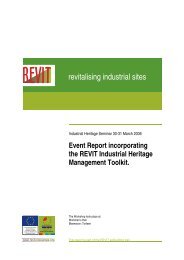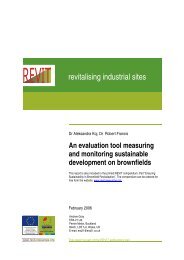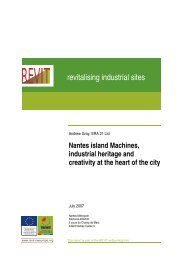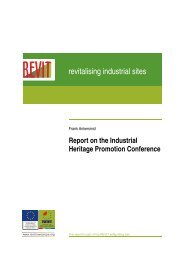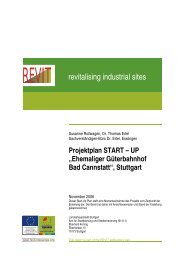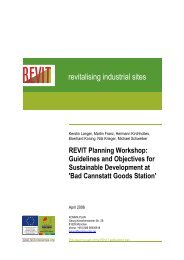REVIT Heritage Report.pdf
REVIT Heritage Report.pdf
REVIT Heritage Report.pdf
Create successful ePaper yourself
Turn your PDF publications into a flip-book with our unique Google optimized e-Paper software.
Torfaen County Borough Council<br />
<strong>REVIT</strong>: A Review of the Conservation of Industrial <strong>Heritage</strong> Assets on Brownfield Sites<br />
to the local authority on the implications of developments on the built heritage<br />
and provide guidance on listed building and Conservation Area applications.<br />
3.3 Wales<br />
<strong>Heritage</strong> Bodies<br />
3.3.1 The Department for Culture, Sport and the Welsh Language looks after<br />
heritage issues in Wales and forms part of the Welsh Assembly Government.<br />
3.3.2 In Wales various government supported bodies protect and manage the<br />
archaeological and built heritage. These organizations recommend to the<br />
ministry the buildings for listing, monuments for scheduling and landscapes,<br />
parks and gardens for registering as well as retaining the definitive base data<br />
on protected such sites.<br />
3.3.3 In Wales, Cadw (Welsh Historic Monuments) is the executive organization<br />
responsible for the protection of archaeological sites, monuments, listed<br />
buildings, parks, gardens and landscapes. In addition, in Wales unlike<br />
England, the Royal Commission on Ancient and Historical Monuments of<br />
Wales (RCAHMW) still remains separate from Cadw.<br />
3.3.4 The Welsh planning authorities are advised by regional Archaeological Trusts,<br />
who are separate from the local authority. These archaeological groups<br />
maintain databases of their areas called the Sites and Monuments Record<br />
(SMR), but now increasingly known as Historic Environment Records (HER).<br />
3.3.5 The various Welsh local authorities also generally retain their own architectural<br />
and landscape conservation staff. The conservation staff provides advice to<br />
the local authority on the implications of developments on the built heritage<br />
and provide guidance on listed building and Conservation Area applications.<br />
Legal Framework England and Wales<br />
3.3.6 The statutory framework for the protection and management of England and<br />
Wales’ cultural heritage is provided by two Acts. The Ancient Monuments and<br />
Archaeological Areas Act 1979, is the primary legislation for the protection of<br />
archaeological remains. The Planning (Listed Buildings and Conservation<br />
Areas) Act 1990 protects the built heritage.<br />
3.3.7 The former act protects nationally important sites as Scheduled Ancient<br />
Monuments (SAMs) as well as recommending preservation in situ for<br />
nationally significant sites, whether they are scheduled or not. The latter act<br />
provides statutory protection for the built heritage in the form of listed buildings,<br />
which are defined as being of special architectural and historic interest, and<br />
Conservation Areas, which are areas of special architectural and historic<br />
interest, the appearance of which it is desirable to preserve or enhance.<br />
3.3.8 In addition Hedgerow Regulations (Section 97, The Environment Act, 1997)<br />
sets out a presumption in favour of retaining historic hedgerows and<br />
‘hedgebanks’ (with hedges) which are over 20m in length and older than 30<br />
years that are considered to be historically, ecologically or visually important.<br />
3.3.9 Each local planning authority in England and Wales, within the scope of the<br />
Town and Country Planning Act publishes its own Local or Unitary planning<br />
policies which usually include policies on the protection of archaeological sites<br />
and monuments, listed buildings and conservation areas.<br />
0014021/JM/001 6




